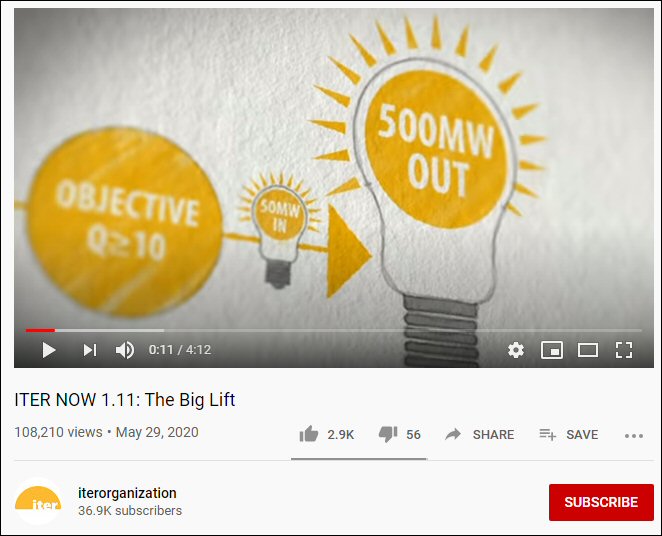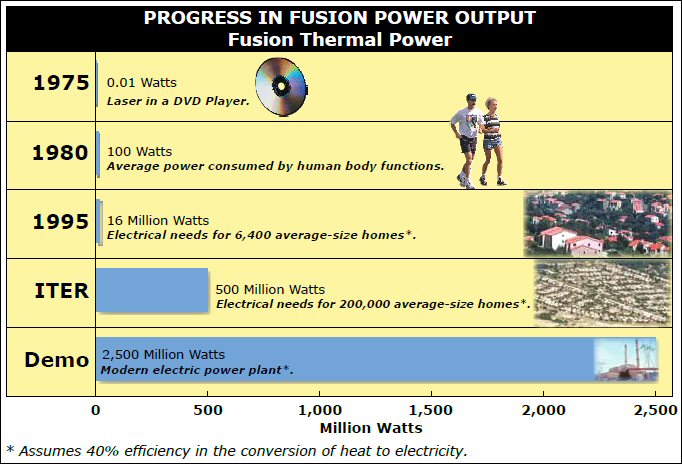#59. Omitting the ITER Input Power – Bigot and Coblentz’s Roles
Return to ITER Power Facts Main Page
By Steven B. Krivit
Nov. 14, 2020

ITER Organization publicity event, July 28, 2020. Bernard Bigot (left); Laban Coblentz (right)
Inconceivable
I remember speaking on the phone with Henry Fountain, the New York Times journalist who wrote that ITER “will produce about 10 times more power than it consumes.” I spent 20 minutes explaining to him that, if the project is successful, the reactor will produce only about the same rate of power as it consumes. For the next 10 minutes, Henry kept saying, “But there must be some misunderstanding; you must have some misunderstanding.”
Henry couldn’t imagine that, during his visit to the ITER reactor site in France, Laban Coblentz, the head of communications for the ITER organization, could have pulled the wool over his eyes and and misrepresented the facts. It’s well known, of course, that it’s much easier to fool someone than it is to convince them that they been fooled. The fusion power discrepancies were inconceivable to me too when I first stumbled on them. Some perspective may help.
Most of my colleagues in mainstream science journalism who write about fusion are now aware of what’s going on. But this is an ugly story, and there is there is little incentive to reporting the story. Yet the public needs to know what it is getting for the project it is funding. It needs to be informed about what this science experiment is and is not expected to do. Elected officials need to make informed decisions on behalf of the public. Other participants in the scientific community need to know the facts. So do many people in the energy and environment sectors.
Winning Formula
Four years ago, a journalist who was enthusiastic about fusion research sneered when I began reporting on the ITER power discrepancies. He said that I couldn’t be proposing the existence of a worldwide conspiracy by fusion scientists to fool everyone.
Yet, as hundreds of examples show, government staff writers in the U.S., the U.K., and Europe, journalists in many countries, and elected officials, at least in the U.S. where I have looked, have been misled by the statements from fusion experts. A conspiracy is not required to explain what happened; the misleading statements seemed to work, led to continued funding, so they continued the practice.
The practice of making misleading claims about fusion reactors has been going on at least since 1978 when Anne Davies, then a U.S. Department of Energy fusion program manager, spoke with a journalist from Popular Science. Davies said that the next big fusion reactor, the Princeton Tokamak Fusion Test Reactor, was intended to “get out as much energy as we put in” and that “TFTR will achieve not just a power breakeven but it will be a net power producer in terms of heat.”
Fact-check: TFTR consumed high-grade electrical power at a rate of 950 MW and in return produced low-grade thermal power from fusion at a rate of 10 MW.
There is no evidence in the article that she told the journalist that when she was talking about the concepts of breakeven, or net power, that she was only comparing the reactor output to the injected thermal power. Everything in the article indicates that she led the journalist to believe she was comparing the reactor output to the overall electrical input for the reactor.
When I interviewed Davies, she blamed the Popular Science journalist for failing to understand her. Davies told me that she intended to inform the journalist that the rate of thermal power produced by the fusion particles would be greater than the rate of thermal power used to heat the fusion fuel. But the Popular Science article gives no indication that Davies attempted to explain this to the journalist. And the same thing happened when Davies spoke with other journalists in years following. After Davies testified before Congress in 1993, Senators J. Bennett Johnston (D-LA) and Bill Bradley (D-NJ) also came away with the same misunderstandings as Davies had given the journalists.
But this is not just about Davies. Every fusion expert whose congressional testimony I have reviewed uses similar language, similar terms, and similar omissions.
As Davies had done, fusion scientists and their promoters learned that they could swap out the injected heating power value for the reactor operating power value and nobody would notice. Or if any experts had noticed, they chose to stay silent, thus fostering an open secret in the community. Once this precedent in public communication of fusion reactor claims was set, and the expectation was established, it became difficult or even impossible to correct the misleading practice.
Decades ago, fusion scientists and their promoters learned that they could use the phrase “fusion power” for two meanings, one practical and one scientific, without defining the scientific meaning. This ambiguity allowed them to incorrectly promote ITER as a reactor that is designed to produce “500 megawatts of fusion power,” when the reactor, as a system, is actually designed to produce zero net power.
See No Evil, Hear No Evil
For readers who have not seen examples of the victims of the deception, here is a sampling of the hundreds of fundamentally incorrect statements about ITER, written by authors who did not realize they were wrong.
- The Austrian Chamber of Commerce wrote that ITER “will reach industrial size with a capacity of 500 MW. … The energy consumption will be 50 MW; the output, ten times.”
- The French Commission Nationale du Débat Public, charged with the responsibility to facilitate open debate and discussion, told villagers in the French countryside where ITER was to be built, that “L’objectif final affiché est de générer une puissance de 500 MW durant plus de six minutes à partir d’une puissance de 50 MW.” [“The final objective displayed is to generate a power of 500 MW for more than 6 minutes from a power of 50 MW.”]
- The European Commission told participants in its ITER Industry Day conference, “By producing 500 MW of power from an input of 50 MW — a gain factor of 10 — ITER will be the stepping stone for future demonstration of the feasibility of fusion power plants.”
- The European Parliament staff told members of Parliament that “ITER is designed to produce 500 MW of fusion power from 50 MW of input power, i.e., a tenfold return on energy.”
- The White House issued a press release saying that, “If successful, ITER would create the first fusion device capable of producing thermal energy comparable to the output of a power plant, making commercially viable fusion power available as soon as 2050.”
- Representative Eric Swalwell Jr. (D-CA) said in a congressional fusion hearing, “Now is the right time to build and operate experiments that can finally demonstrate that a man-made fusion system can consistently produce far more energy than it takes to fuel. For the magnetic fusion approach, the next episode clearly is ITER. ITER is designed to produce at least 10 times the energy it consumes.”
- Davide Castelvecchi and Jeff Tollefson wrote in Nature that ITER “is predicted to produce about 500 megawatts of electricity.”
- Robert Stern wrote in The New York Times that “ITER would provide a record 500 megawatts of fusion power for at least 500 seconds, a little more than eight minutes, during each experiment. That would meet the power needs of about 140,000 homes.”
Nobody in the fusion community objected to these false statements. Perhaps that’s because every one of these falsehoods favorably exaggerated the perceived value of ITER.
The Press Release
On July 28, 2020, Coblentz, under the leadership of Bernard Bigot, the director-general of the ITER organization, directed a staff member, without her understanding, to publish a press release with an even bolder false claim about the reactor:
When ITER is finished, it is expected that it will demonstrate that fusion power can be generated sustainably on a commercial scale. … How much power will the ITER Tokamak provide? The plant at ITER will produce about 500 megawatts of thermal power. If operated continuously and connected to the electric grid, that would translate to about 200 megawatts of electric power, enough for about 200,000 homes.
Bigot and Coblentz omitted all of the electrical input power the reactor is designed and expected to consume. Had Bigot and Coblentz included the input power, and if ITER was connected to the electric grid, ITER’s net output would translate to about zero Watts of electricity. The ITER design, “if operated continuously and connected to the electric grid,” isn’t enough to power a single light bulb.
Had any solitary federally funded scientist made such an outrageously false claim in a press release, the person would have been branded a fraud and forced to bear the stigma for the remainder of his or her career. But this is ITER, which is sending $25 billion to $65 billion of public money to thousands of fusion scientists, engineers, and contractors who are working on the project.
The press release was issued to announce the fact that the ITER organization was beginning the assembly phase of the reactor. That milestone is a decade behind schedule.
The day after the press release, I called Sabina Griffith, the staff member in the ITER organization’s public relations office whose name appeared on the press release. Griffith consented to an audio recording of our telephone call. In our conversation, it became clear that she did not have sufficient understanding of the scientific details to understand the press release bearing her name. But she didn’t write it, and she disavowed responsibility for the statements.
“I’m not the spokesperson of ITER. I’m a press officer,” Griffith said. “I’m just providing media, so for this question, regarding the content of the press release, I would have to ask you to talk to Laban Coblentz who is our head of communications. … I am not responsible for the statement printed in the press release.”
I sent an e-mail to Coblentz, Griffith, and Bigot and asked them if there had been a mistake. Nobody responded.
The press release, uncorrected, is still on the EurekaAlert! Web site, which is operated by the American Association for the Advancement of Science. (AAAS disclaims responsibility for the accuracy of news releases posted to the site.)
Dynamic Duo
Bigot hired Coblentz in September 2015, after the departure of Michel Claessens, the prior head of communications. Toward the end of his employment with the organization, Claessens told me, he began asking senior management about the ITER organization’s public power claims. Claessens now works for the European Commission and is the author of the 2020 book ITER: The Giant Fusion Reactor. Claessens is enthusiastic about the project, but he is also transparent about his critique of the project in his book.

Coblentz coaching Bigot before they went into a 2016 U.S. House of Representatives meeting to ask for continued funding for ITER. (Image courtesy eyesteelfilm)
Sometime between Nov. 8, 2015, and Nov. 13, 2015, within two months of his September hire date, Coblentz overhauled the organization’s Web site and significantly expanded the organization’s publication of the false power claims, focusing on the false claim that the reactor was designed to produce 500 megawatts of output power from only 50 megawatts of input power.

ITER organization’s Web site homepage, image retrieved Jan. 12, 2017
The following year, in 2016, Bigot and Coblentz went to Washington, D.C., to encourage members of Congress to continue giving the public’s money to the ITER project. The video clip below from the hearing shows Bigot testifying before Congress that the ITER reactor will produce 500 megawatts of power with an input of only 50 megawatts.
“ITER will have delivered the full demonstration that we could have 500 megawatts coming out of the 50 megawatts we will put in.”
A year later, I learned through my investigation that the reactor would require an electrical input power rate of 300 MW, not 50 MW, to produce the 500 MW result. I published that information in October 2017 along with a list of false and misleading claims on the ITER organization’s Web site. Within a month, Bigot and Coblentz corrected many of the false statements.
But they continued to publish claims that were “only” misleading. The “50 MW in – 500 MW out” idea conveys valid meaning for people who understand the nuances of fusion research. For everyone else, it is deceptive.

“50 MW in – 500 MW out” claim published in ITER Organization promotional videos. (Image retrieved July 27, 2020)
In 2018, Bigot testified before Congress again, but this time, instead of claiming that ITER would have an output of 500 megawatts for an input of 50 megawatts, he qualified the output as “fusion power.” For people who didn’t know the undisclosed scientific meaning of “fusion power,” his claim still exaggerated the apparent intended output of the reactor. Congress signed the check and kept the U.S. scientists and contractors in the ITER game.
Monkey See, Monkey Do
I mentioned that Davies’ congressional testimony in 1993 was echoed and reinforced by other respected fusion authorities. In the same way, Bigot and Coblentz are not lone players in the present-day situation. Many of my previous reports have shown similar patterns of falsehoods. As I show below, the “200,000 Watts/200,000 homes” false claim has been popular among the fusion leadership.
It was one of several false claims that Johannes Schwemmer, the director of the ITER European domestic agency, made for several months earlier this year until the European Commission instructed him to stop.
Schwemmer’s organization is responsible for the on-site construction of the ITER project. At least €4.4 billion of taxpayer money has flowed through his organization to more than 550 companies, 1,800 subcontractors and at least 70 R&D organizations working on the project.
The Princeton Plasma Physics Laboratory participated in the “200,000 Watts/200,000 homes” false claim for nearly a decade. It showed up in a brochure on the Princeton University Web site and on the U.S. Department of Energy PPPL Web site.

Image from brochure on the Princeton University and the U.S. Department of Energy PPPL Web sites.
Before becoming the current director of the Princeton Plasma Physics Laboratory, Steve Cowley, the former director of the United Kingdom Atomic Energy Authority, was also fond of the “200,000 Watts/200,000 homes” false claim. Here’s a video clip in which he made the claim during a lecture he gave at the Oxford Martin School.
Teamwork
I’ve written to Bigot twice, once in 2017 and again in 2018. I wrote to him a third time, on Nov. 3, 2020. I politely encouraged him to fix the claims on his organization’s Web site, and I encouraged him to be more accurate and transparent. He did not respond. He’s directed his staff to fix the false statements but not the misleading statements. In his personal statements about ITER, he’s been careful to avoid making false power claims. However, in advance of his lectures, members of his staff have been including the exaggerated power claims in the announcements for those lectures.
Two recent examples are the lecture Bigot gave remotely in 2020 through Princeton University and his presentation in 2019 at the World Conference of Science Journalists. The abstract for that lecture told journalists that the ITER reactor was designed to produce 10 times its input energy. Years after Bigot and Coblentz clearly understood the power values for ITER, they have consistently shown their intent to mislead the public and the news media.

